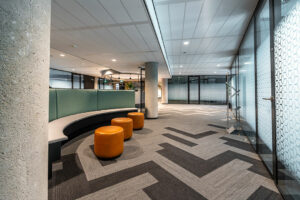By Beatriz Marie D. Cruz, Reporter
THE OFFICE MARKET in Metro Manila is poised for a rebound by year-end, with demand from the information technology-business process management (IT-BPM) sector expected to offset record-high vacancies, according to real estate services firm CBRE.
In its Third Quarter Property Market Report, CBRE said office vacancy in Metro Manila rose 4.4% to 20.8% from 19.9% in the same period last year. Quarter on quarter, vacancy also increased 2.4% from 20.3% in the second quarter.
“Two factors contributed to this — additional vacated spaces from the POGO (Philippine Offshore Gaming Operators) sector and new office building completions for the quarter,” CBRE Philippines Country Head Jie C. Espinosa said in an e-mailed reply to questions.
As of end-September, vacated spaces in Metro Manila reached 1.06 million square meters (sq.m.), accounting for 56% of the region’s available supply. In the third quarter alone, vacated spaces totaled 136,230 sq.m., with 55% coming from POGO exits, 28% from traditional firms, and 15% from the IT-BPM sector.
By submarket, the Bay Area recorded the highest vacated spaces at 331,000 sq.m., followed by Makati (246,400 sq.m.), Quezon City (189,700 sq.m.), Fort Bonifacio (138,400 sq.m.), and Alabang (108,400 sq.m.).
“After a pandemic, two waves of POGO diaspora and fluctuations in IT-BPM take-up, vacated spaces finally breached the one-million mark,” CBRE said.
Despite the high vacancies, Mr. Espinosa said “demand will continue to be healthy and we could see an improvement in terms of vacancy.” Net take-up in the July-September period doubled 53.43% to 248,100 sq.m. from 161,700 sq.m. in the same period in 2024, marking the third consecutive quarter of over 200,000 sq.m. of take-up.
Year to date, office take-up stood at 689,300 sq.m., driven by transactions from the IT-BPM sector, traditional offices, and government tenants. However, CBRE noted that IT-BPM demand has steadily declined over the last two years.
“Inasmuch as a decline was noted in 2023 and 2024, we are also anticipating a major bounce back for 2025,” Mr. Espinosa said.
Metro Manila currently has about 1.9 million sq.m. of office inventory, of which 56% are vacated spaces and 44% are new and unleased. The Bay Area has the largest available supply at 492,800 sq.m., followed by Makati City (375,800 sq.m.), Quezon City (375,100 sq.m.), Alabang (241,400 sq.m.), Fort Bonifacio (215,900 sq.m.), and Ortigas (196,900 sq.m.). CBRE expects new office supply to enter the market in 2026-2028 at 303,900 sq.m., 236,400 sq.m., and 327,300 sq.m., respectively.
Outside Metro Manila, Cebu leads the provincial office market with 42,800 sq.m. of take-up in the third quarter, followed by Clark, Pampanga (18,300 sq.m.) and Cavite (2,000 sq.m.). Available provincial office space totals 511,200 sq.m., primarily in Cebu (205,500 sq.m.), Pampanga (128,400 sq.m.), and Iloilo (91,000 sq.m.).
“National developers are banking on GCCs (global capability centers) to expand in tier-one provincial locations and leverage on a rich pool of talent in those areas,” CBRE said.
Meanwhile, the industrial sector saw third-quarter demand rise 17% to 160,190 sq.m. from 136,910 sq.m. a year ago, covering the Cavite, Laguna, and Batangas (Calaba) region, which has 4.03 million sq.m. of total available land and 86,790 sq.m. of upcoming warehouse space.

